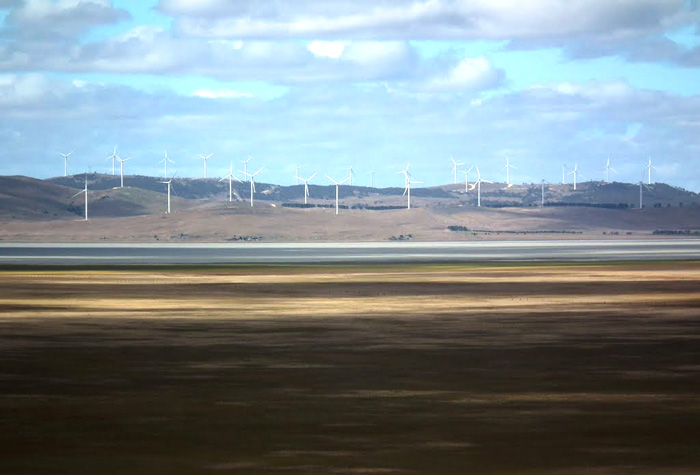Joe Hockey claims his aversion to wind turbines is an aesthetic issue, but it’s clearly ideological. [21 July 2015 | Peter Boyer]
“I find those wind turbines around Lake George to be utterly offensive” (Joe Hockey, May 2, 2014)
“Not only are they visually awful, but they make a lot of noise” (Tony Abbott, June 12, 2015)
We all see things differently, I know, but I just don’t get how the prime minister and his treasurer could have such distressing aesthetic problems with wind farms.

“Utterly offensive” wind turbines, Capital Wind Farm on the shores of Lake George, near Canberra. PHOTO Alan Farlow/Leumeah
Wind turbines are big and there are more of them than in times past, and I accept that their simple design, smooth curves and uniform whiteness may not appeal to some.
But amid the vast array of ugliness that industrial societies have produced, what would cause anyone to single out wind turbines as “utterly offensive”? It makes no sense. There’s something else in play here.
Our quest for truly renewable energy – energy harnessed directly from a natural source without depleting that source – is now moving predominantly along two pathways, wind and rooftop solar. Both technologies are now ubiquitous throughout the world.
Solar panels are passive instruments, using unseen photovoltaic wizardry to turn sunlight into electricity. But we can see wind turbines at work. Their huge blades moving in the breeze – ancient technology for a new age – are the most potent of symbols for the renewable era.
This gets to the heart of the matter. Joe Hockey claims that he doesn’t like wind energy for aesthetic reasons, but protracted vilification of the industry by key government figures says otherwise. This isn’t aesthetics. It’s ideology.
Last week, Joe Hockey and finance minister Mathias Corman said the Clean Energy Finance Corporation – another target of government wrath – had been instructed to stop funding wind projects, along with rooftop solar.
Environment minister Greg Hunt explained this as returning to the CEFC’s original purpose, which he described as “to finance only genuinely innovative renewable energy technologies”. He made special mention of large-scale solar enterprises.
But the CEFC act makes no mention of innovation. The CEFC is charged with providing a return to the government from investment in renewable or low‑emission energy and energy efficiency.
Previously, the government also instructed the CEFC to improve returns on its investments, which would suggest that innovative technology is out of the frame. So what does the government want: innovation or better returns? As any investor knows, it can’t have both.
Wind and photovoltaic solar have consistently given the best investment returns of the renewables, well ahead of solar thermal (generating electricity from the sun’s heat) and such outliers as geothermal, wave and tidal energy. But the past couple of years have seen wind power projects struggle to get investor funding in the face of market uncertainty driven by unrelenting opposition from government and some cross-bench MPs and senators.
The loss of CEFC funding is going to be a heavy blow. To add to the industry’s woes, the government has said it will instigate yet another study of claims that wind turbines make people sick. This is despite the fact that not one of numerous scientific studies over the past decade, here and overseas, have found any evidence for this.
Tristan Edis of Climate Spectator suggested last week that money is a factor in the government’s current attitude, claiming it was a response to pressure from party supporters with large-scale solar interests, anxious to see their projects get some traction.
The Australian Renewable Energy Agency (the arm of government which unlike the CEFC really does have responsibility for renewable innovation) lent some credence to this with last week’s announcement that large-scale solar was a funding priority.
Greg Hunt sees this as good strategy, and indeed we do need more large-scale solar to help wean utilities off coal. But it’s worrying that overall investment in renewable energy in Australia is going nowhere while globally it’s rising sharply.
The government’s manoeuvres last week came after many months of uncertainty over the renewable energy target resulting from the the Warburton inquiry and repeated accusations from government circles that renewable energy was too expensive.
It’s clear that the government wants to halt the forward progress of renewable energy. In the context of Australia’s clear and pressing need to cut carbon emissions, that is grossly irresponsible.
